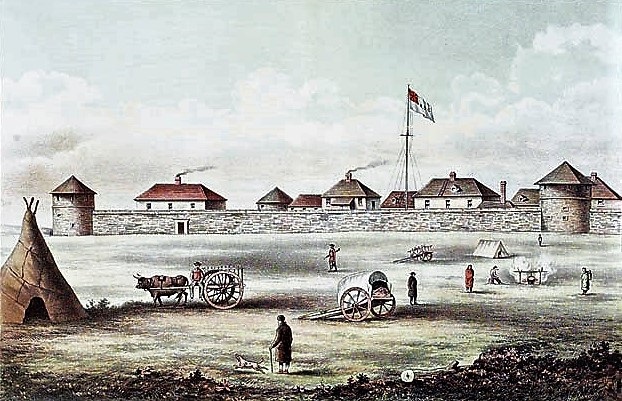***photo credit George Penner @Whitemouth Photography 2019
The landscape around the confluence of the Red and Assiniboine Rivers, in what is now Winnipeg, Manitoba, and stretching north towards Lockport, is steeped in history. It's a story woven from Indigenous presence, the ambitions of the Hudson's Bay Company (HBC), the vital artery of the Red River, and the eventual harnessing of the power of Lockport Falls. Understanding this history requires examining the distinct yet intertwined narratives of Lower Fort Garry, Upper Fort Garry, the HBC's broader influence, the significance of the Red River, and the transformation of Lockport.
The Indigenous Foundation:
Before the arrival of European fur traders, the region was home to various Indigenous peoples for millennia. The confluence of the Red and Assiniboine Rivers was a significant meeting place, a hub for trade, hunting, fishing, and spiritual ceremonies. The rich lands and waterways provided sustenance and facilitated travel and communication. The Anishinaabe (Ojibwe), Cree, Dakota, and Assiniboine peoples, among others, had established complex social structures, governance systems, and deep connections to the land. Their traditional knowledge of the environment, including the rivers and their resources, would later be crucial for the survival and success of the European newcomers.
The Arrival of the Hudson's Bay Company and the Fur Trade:
The Hudson's Bay Company, chartered by the English Crown in 1670, was granted a vast territory known as Rupert's Land, encompassing the entire watershed draining into Hudson Bay. The primary objective of the HBC was to control the lucrative fur trade, particularly beaver pelts, which were highly prized in Europe.
Initially, the HBC established trading posts along the shores of Hudson Bay, relying on Indigenous peoples to bring furs to them. However, as competition from the North West Company (NWC), a Montreal-based fur trading enterprise, intensified in the late 18th and early 19th centuries, the HBC was forced to move inland and establish posts closer to Indigenous hunting grounds.
The Genesis of Fort Garry (Upper Fort Garry):
The first HBC post in the immediate vicinity of the Red River confluence was established in 1738 by Pierre Gaultier de Varennes, sieur de La Vérendrye, a French explorer and trader who predated the HBC's significant inland expansion in this area. This post, known as Fort Rouge, was short-lived.
The more direct precursor to Upper Fort Garry was Fort Gibraltar, established by the North West Company in 1810 at the strategic junction of the Red and Assiniboine Rivers. This location was ideal for controlling trade routes and accessing the rich fur-bearing regions to the west and south.
The rivalry between the HBC and the NWC was fierce and often violent. In 1816, the Battle of Seven Oaks, a clash between HBC employees and NWC Métis allies, resulted in significant casualties and heightened tensions.
In 1821, the two competing companies merged under the name of the Hudson's Bay Company. To consolidate their operations at the Red River confluence, the HBC rebuilt and expanded Fort Gibraltar, renaming it Fort Garry in 1822, in honour of Nicholas Garry, the Deputy Governor of the HBC at the time. This fort became the administrative and commercial heart of the Red River Colony, a settlement established by Lord Selkirk starting in 1812.
Upper Fort Garry's Role:
Upper Fort Garry was more than just a fur trading post after the merger. It became the central hub for the HBC's operations in the vast Red River District. Its functions included:
Administration: It housed the offices of the Governor of Assiniboia (the district surrounding the Red River Colony) and other HBC officials who oversaw the trade, land management, and governance of the region.
Commerce: It served as a major depot for furs being collected from the interior and for goods being distributed to the various HBC posts and the settlers.
Social Centre: It was a focal point for the growing Red River settlement, hosting social gatherings, religious services, and providing a degree of security.
Defence: While not primarily a military fortification in the later years, it provided a defensible location in a sometimes volatile environment.
The HBC's control over the Red River Colony and its inhabitants was significant. They held considerable economic and political power, shaping the lives of the settlers, the Métis population (descendants of European fur traders and Indigenous women), and the Indigenous communities.
The Story of Lower Fort Garry:
While Upper Fort Garry became the administrative and commercial centre, the HBC also recognized the need for a more secure and strategically located depot further down the Red River. This led to the establishment of Lower Fort Garry, also known as Stone Fort, approximately 32 kilometers (20 miles) north of the Forks (the confluence of the Red and Assiniboine).
Construction on Lower Fort Garry began in the early 1830s under the direction of Governor George Simpson. Several factors contributed to the decision to build a new, more substantial post downstream:
Flooding: Upper Fort Garry was susceptible to flooding from the Red and Assiniboine Rivers, which could disrupt operations and damage valuable goods. Lower Fort Garry was built on higher ground, offering greater protection.
Transportation: While the Forks were central, the lower reaches of the Red River offered better access to Lake Winnipeg and the northern trade routes, particularly for larger York boats used for transporting goods to and from Hudson Bay.
Agriculture: Lower Fort Garry was situated in a more fertile agricultural region, allowing the HBC to establish a significant farm to supply provisions to its posts and the growing settlement, reducing reliance on long-distance transportation of food.
Security: The stone construction of Lower Fort Garry provided a more formidable defensive structure compared to the wooden palisades of Upper Fort Garry, offering greater security against potential threats.
Lower Fort Garry quickly became a significant agricultural and depot centre for the HBC. Its impressive stone walls, built by Scottish stonemasons, enclosed a complex of buildings including a Governor's residence, clerks' quarters, a provision store, a bakehouse, and various workshops. It served as a major transshipment point for goods moving between the interior and York Factory on Hudson Bay.

***photo credit Manitoba historical society
The Diverging Roles:
Over time, Upper and Lower Fort Garry developed distinct roles within the HBC's operations and the broader Red River settlement:
Upper Fort Garry: Remained the administrative, commercial, and social heart of the Red River Colony, witnessing significant historical events such as the Red River Resistance led by Louis Riel in 1869-70.
Lower Fort Garry: Became the primary agricultural centre and a major depot for the northern fur trade. Its more substantial construction also saw it used for various other purposes, including as a treaty negotiation site (Treaty No. 1 in 1871) and later as a mental hospital and a military training base.
The Red River: A Lifeline and a Highway:
The Red River was the lifeblood of the region, long before the arrival of Europeans and continuing throughout the fur trade era and beyond.
Transportation: It served as the primary transportation route, connecting Indigenous communities, fur trading posts, and later, the burgeoning settlements. York boats, canoes, and eventually steamboats navigated its waters, carrying furs, goods, and people.
Sustenance: The river provided fish, waterfowl, and access to fertile lands for agriculture. Its annual spring flooding, while sometimes destructive, deposited rich silt that enhanced soil fertility.
Cultural Significance: For the Indigenous peoples, the Red River held deep cultural and spiritual significance, connecting communities and providing essential resources.
The HBC relied heavily on the Red River for its operations. Their posts were strategically located along its banks, and the river facilitated the flow of goods and information throughout their vast territory. The Métis, with their intimate knowledge of the river and its navigation, played a crucial role in the fur trade as voyageurs and provisioners.
Lockport Falls and the Coming of the Dam:
North of Lower Fort Garry, the Red River encountered a series of rapids and a natural waterfall known as St. Andrews Rapids or Lockport Falls. This natural feature presented both a challenge and an opportunity.
Natural Barrier: The rapids and falls made navigation difficult for larger boats traveling further upriver from Lake Winnipeg. Portage routes were necessary to bypass this section of the river.
Potential Power Source: Even before it was dammed, the falls represented a potential source of water power.
The transformation of Lockport Falls into a dam was a significant development in the history of the Red River and the surrounding region, primarily driven by the need for navigation and power.
Early Calls for Navigation Improvements: As settlement increased and the need for efficient transportation grew, particularly for agricultural products, there were calls to improve navigation on the Red River north of Winnipeg. The rapids at Lockport were a major impediment.
The Construction of the St. Andrews Lock and Dam: In the early 20th century, the federal government of Canada undertook the ambitious project of constructing a lock and dam at Lockport. Construction began in 1907 and was completed in 1910.
Purpose and Impact: The primary purpose of the St. Andrews Lock and Dam was to create a navigable channel around the rapids, allowing larger vessels to travel between Lake Winnipeg and the upper reaches of the Red River. The dam also had the potential for hydroelectric power generation, although this was not its initial primary function.
The construction of the lock and dam significantly altered the natural flow of the Red River at Lockport. While it facilitated navigation, it also had environmental consequences, impacting fish migration patterns and the natural ecosystem of the river.
The Legacy Today:
The history of Fort Garry, the Hudson's Bay Company, the Red River, and Lockport continues to shape the identity of Manitoba.
Upper Fort Garry: Only a small gate remains of the once-imposing Upper Fort Garry in the heart of Winnipeg. It serves as a reminder of the city's origins and the pivotal role of the fur trade. The surrounding area has transformed into a modern urban centre.
Lower Fort Garry National Historic Site: Today, Lower Fort Garry is a beautifully preserved National Historic Site, offering visitors a glimpse into the life of a 19th-century Hudson's Bay Company post. Its stone buildings and costumed interpreters bring the history of the fur trade and early settlement to life.
The Red River: Remains a vital waterway, although its uses have evolved. It continues to be used for recreation, transportation (to a lesser extent than in the past), and as a source of water. Its history as a crucial artery of trade and settlement is deeply ingrained in the region's narrative.
The St. Andrews Lock and Dam (Lockport): Still operational today, the lock allows for recreational boating on the Red River. The dam continues to influence the river's flow and has become a popular spot for fishing and enjoying the natural beauty of the area. The surrounding community of Lockport has its own distinct history tied to the falls and the construction of the dam.
The history of the Fort Garry area is a rich tapestry woven with the threads of Indigenous presence, European ambition, the transformative power of commerce, and the enduring influence of the natural environment. The Hudson's Bay Company's establishment of Upper and Lower Fort Garry marked a significant shift in the region's development, transforming it into a central hub of the fur trade and laying the foundation for future settlement. The Red River served as the essential conduit for this activity, shaping patterns of travel, trade, and sustenance. The eventual damming of Lockport Falls represents a later chapter in this history, reflecting the growing desire to harness the river for navigation and power. Together, these elements tell a compelling story of exploration, competition, settlement, and the ongoing relationship between people and the land in the heart of North America. Understanding this intertwined history provides valuable context for appreciating the present-day landscape and the diverse heritage of Manitoba.
***credit a thought , a question & AI


Comments:
Post Your Comment: